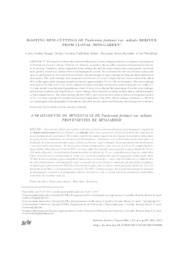Rooting mini-cuttings of Paulownia fortunei var. mikado derived form clonal mini-garden.
Rooting mini-cuttings of Paulownia fortunei var. mikado derived form clonal mini-garden.
Author(s): STUEPP, C. A.; ZUFFELLATO-RIBAS, K. C.; KOEHLER, H. S.; WENDLING, I.
Summary: We aimed to evaluate the technical efficiency of mini-cuttings technique on vegetative propagation of Paulownia fortunei (Seem.) Hemsl. var. Mikado, as well as the possible existence of anatomical barriers to its rooting. Therefore, plants originated from cuttings formed the mini-stumps and, consequently the clonal mini-garden, which was conducted in semi-hydroponic system. We evaluated the survival of mini-stumps and sprouts production for five successive collects, the percentage of mini-cuttings rooting and their anatomical description. The mini-cuttings were prepared with about 6 to 8 cm in length and two leaves reduced by about 50% in the upper third, being remained an area of, approximately 78 cm2 (10 cm diameter). The mini-cuttings were placed in tubes of 53 cm3, with substrate formed with fine vermiculite and carbonized rice hulls (1:1 v/v) and rooted in acclimatized greenhouse. After 30 days we evaluated the percentage of rooted mini-cuttings, radicial vigor (number and length of roots / mini-cutting), callus formation, emission of new shoots and maintenance of the original leaves. The mini-stumps showed 100% survival after five collects and an average production of 76-114 mini-cuttings/m2/month and rooting ranged from 70 to 90%. Mini-cuttings technique is efficient in to propagate adult propagules of the species and there are not anatomical barriers preventing roots emission.
Publication year: 2015
Types of publication: Journal article
Unit: Embrapa Forestry
Observation
Some of Embrapa's publications are published as ePub files. To read them, use or download one of the following free software options to your computer or mobile device. Android: Google Play Books; IOS: iBooks; Windows and Linux: Calibre.
Access other publications
Access the Agricultural Research Database (BDPA) to consult Embrapa's full library collection and records.
Visit Embrapa Bookstore to purchase books and other publications sold by Embrapa.

